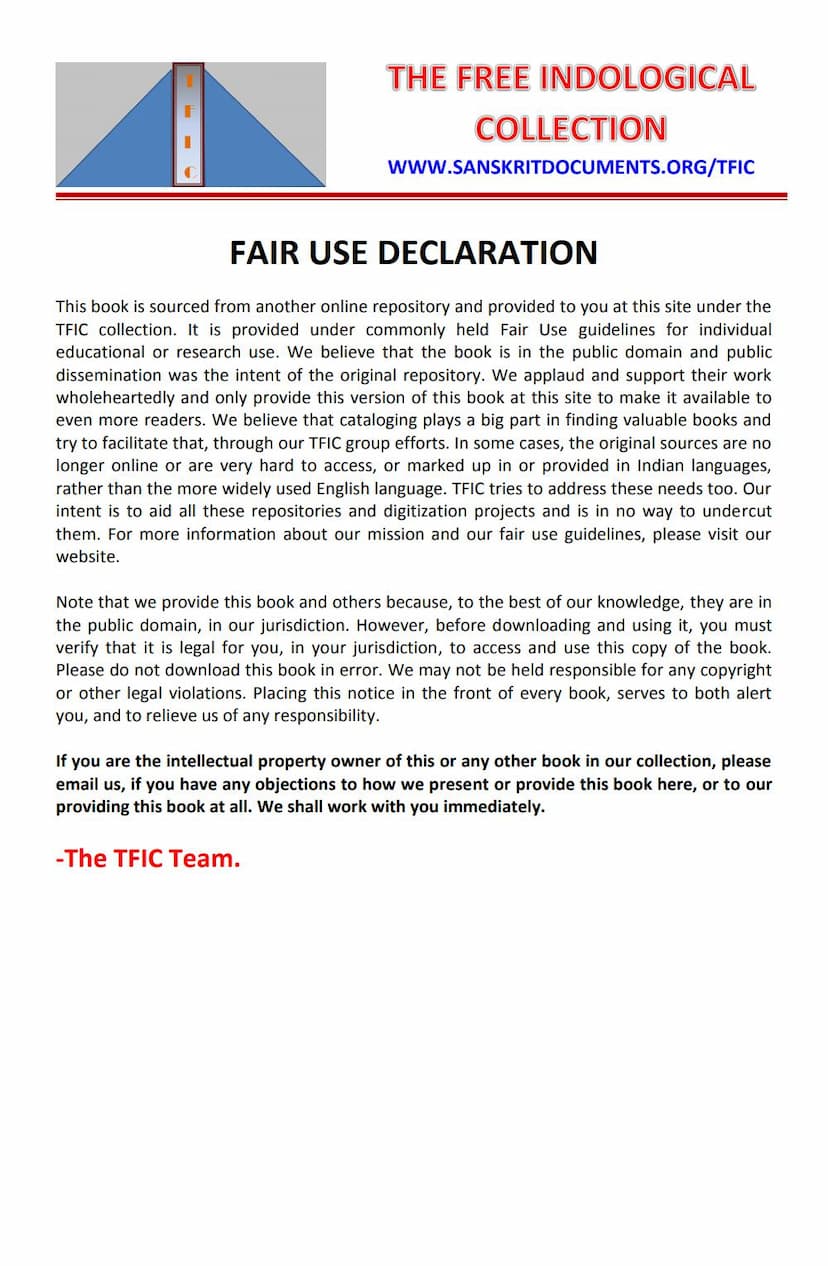Agam 42 Mool 03 Dashvaikalik Sutra Chintanika
Added to library: September 1, 2025

Summary
This document is a detailed commentary and explanation of the Jain scripture "Dashavaikalik Sutra," specifically focusing on the "Mool 03" (meaning the third root text). The title itself, "Dashavaikalik Sutra Chintanika," indicates a deep contemplation and analysis of this important text.
Here's a breakdown of the key aspects covered in this comprehensive summary:
1. Core Text and Authorship:
- The primary focus is the Dashavaikalik Sutra, a foundational Jain scripture.
- The commentary is attributed to Vikramsuri, Rajyashvijay, and Vachamyamashreeji.
- It was published by Shri Labdhi-Vikram-Surishwarji Sanskriti Kendra, Ahmedabad.
2. Purpose and Context:
- The book is presented as a "Chintanika" – a work of deep reflection and thought on the Sutra.
- It aims to elucidate the profound teachings and practical guidance within the Dashavaikalik Sutra for the spiritual benefit of readers.
- The publication is dedicated to the lineage of spiritual masters (Gurus) starting from Paramopakar Shri Jayant-Vikram-Navinsurishwarji Maharaj.
- The commentary is specifically attributed to Sadhvi Varya Vachamyamashreeji, who is presented as a devoted disciple and scholar.
3. Key Themes and Content: The core of the commentary seems to revolve around the verses and teachings of the Dashavaikalik Sutra, presented chapter by chapter or verse by verse. Based on the Table of Contents and the introductory pages, the content covers:
-
Spiritual Principles and Practices: The text delves into various aspects of the Jain spiritual path, likely including:
- Right Conduct (Achar): Emphasizing the importance of disciplined behavior for ascetics.
- Vairagya (Detachment): Cultivating detachment from worldly pleasures and possessions.
- Samyama (Self-Control): The foundational practice of controlling senses and desires.
- Tapa (Austerities): The role and significance of various forms of penance.
- Jnana (Knowledge): The pursuit and understanding of right knowledge.
- Dhyana (Meditation): The importance of mental focus and contemplation.
- Anupreksha (Contemplation): Deep reflection on various spiritual truths.
- Vastness of Jain Scriptures: Highlighting the depth and breadth of Jain Agamas.
-
The Role of Sadhvis (Nuns) in Jainism: The introductory sections strongly emphasize the significant contributions of Jain nuns to the study and propagation of scriptures. It mentions historical examples of learned and influential Sadhvis who have enriched Jain literature.
-
The Significance of the Dashavaikalik Sutra:
- It is described as a "Maha Granth" (great scripture) for ascetic conduct.
- It is noted for its "Gauravbhurya Sthan" (prestigious place) in the Jain tradition.
- The Sutra's verses are considered fundamental for daily spiritual practice, including its recitation before meals and its role in the initiation ceremonies (Upasthapana).
-
Philosophical Insights: The text likely explores Jain philosophical concepts such as:
- Ahimsa (Non-violence): As a foundational principle that permeates all actions.
- Anekantavada (Multiplicity of Viewpoints): The Jain principle of looking at things from multiple perspectives.
- The Nature of the Soul (Atma): Understanding the soul's inherent purity and its journey.
- Karma: The intricate workings of karma and the process of its shedding.
-
Commentary and Explanation: The work provides detailed commentary, likely breaking down each verse or concept with explanations, interpretations, and possibly historical context.
4. Structure and Presentation:
- The book includes an Anukramanika (Table of Contents) listing the various verses and topics discussed.
- There are "Ashirvachan" (Blessings) and "Sampadakiya" (Editorial) sections, providing context and appreciation for the work.
- The "Lekhika na Antar Udgar" (Author's Inner Thoughts) offers personal reflections and the inspiration behind the commentary.
- The "Dashavaikalik Sutra ni Sahitya Yatra" (Literary Journey of Dashavaikalik Sutra) section provides valuable background information on the Sutra's composition and its place in Jain literature.
5. Publisher's and Author's Gratitude:
- The publisher expresses immense joy and gratitude to Sadhvi Varya Vachamyamashreeji for her scholarly work.
- Special thanks are given to Shrimati Kanchanben and Sanghvi Khimchandbhai for their financial support, highlighting them as ideal Jain couples dedicated to religious service.
- Acknowledgement is also made to Shri Rajendra A. Dalal (Publication Secretary) and others involved in the printing and production.
In essence, this book is a scholarly and devotional exposition of the Dashavaikalik Sutra, aimed at deepening the reader's understanding and practice of Jain principles. It highlights the importance of rigorous study, sincere devotion, and the continuous effort to live by the teachings of the Tirthankaras, particularly emphasizing the role of ascetics in preserving and transmitting this profound knowledge.